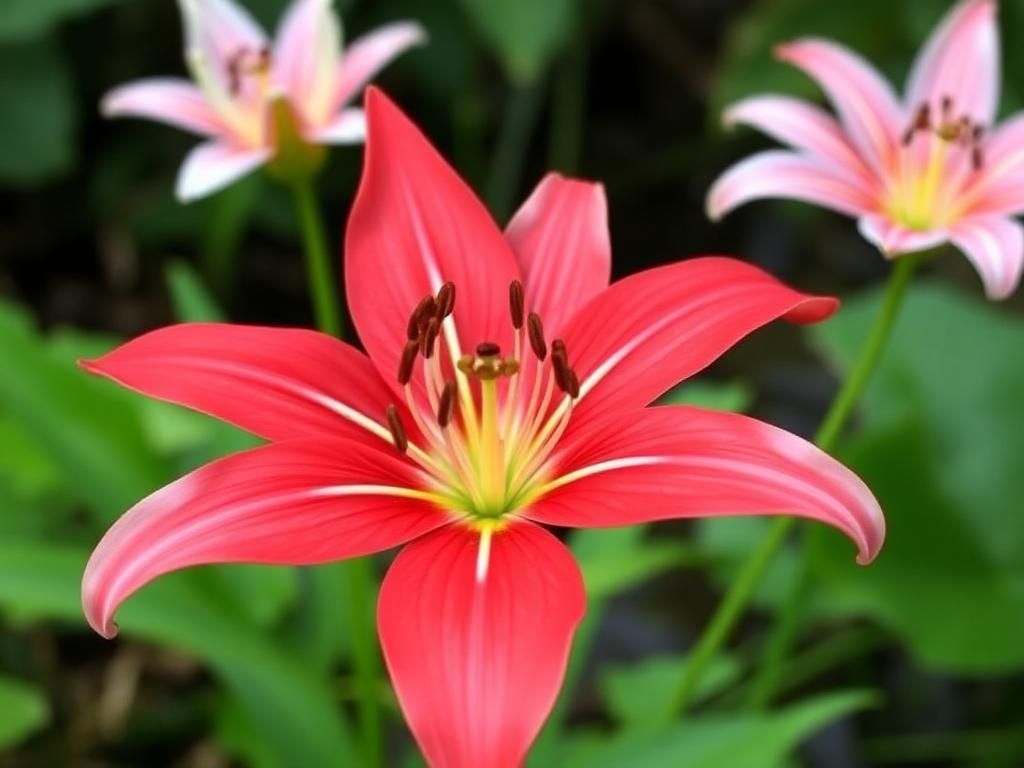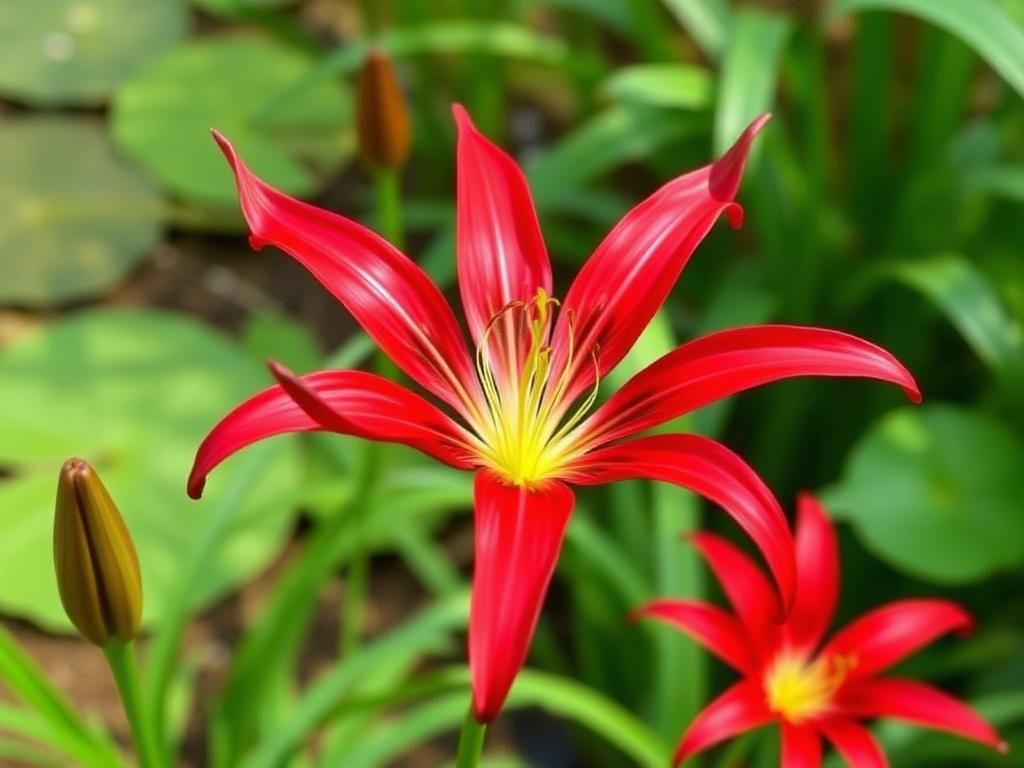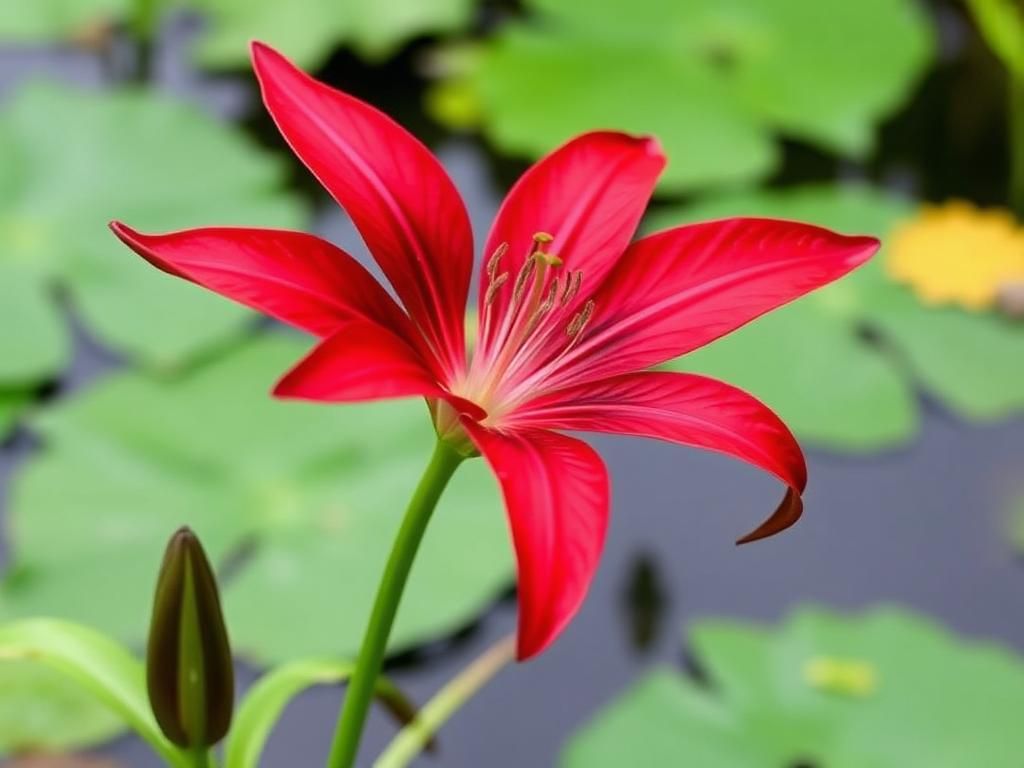The red spider lily (Lycoris radiata) is a captivating flower that enchants gardeners and flower enthusiasts alike with its striking appearance. Known for its vibrant red petals that resemble the delicate legs of a spider, this perennial plant flourishes in late summer to early autumn. Beyond its stunning visuals, the red spider lily carries deep meanings and rich cultural significance. This article aims to explore the multifaceted red spider lily meaning across various cultures and its symbolic connections to life, death, and rebirth.
Botanical Characteristics of Red Spider Lily
Description and Appearance
The red spider lily is a remarkable flower with unique attributes. Its elongated style and frilled petals are a key characteristic that gives it a distinct look, resembling the limbs of a spider. While its signature color is a vivid red, it can also bloom in white, yellow, and pink varieties, though these are less common. Often found in clusters, the dramatic appearance of these flowers makes them a favorite among landscape artists and home gardeners alike.
The ideal growing conditions for Lycoris radiata include well-drained soil and partial shade. This adaptability allows the flower to thrive in various settings, from suburban gardens to wild landscapes. Gardeners appreciate the fact that these flowers require minimal care, blooming beautifully without extensive maintenance.
Life Cycle and Growing Habits
Red spider lilies bloom in late summer, typically from August to September, providing a stunning spectacle as they burst forth from underground bulbs. They are perennial plants, meaning that they return year after year, thanks to their well-developed bulb system that stores nutrients and energy.
The geographic distribution of the red spider lily is broad, primarily found in Asia, particularly in regions such as Japan and China. It has also gained popularity in other parts of the world, including North America, where it is cultivated for its ornamental value.
Symbolism of Red Spider Lily
General Symbolic Meanings
The red spider lily meaning encompasses themes of beauty, transience, and the natural cycles of life. Its brief blooming period signifies the ephemeral nature of existence, reminding us of the fleeting moments we often take for granted. In addition, it serves as a powerful emblem of death and rebirth, reflecting the continuous cycle of life and the intertwining of endings with new beginnings.
Cultural Interpretations
In different cultures, the symbolism of the red spider lily varies significantly.

In Asian Cultures
- Japan: Known as Higanbana, the red spider lily symbolizes farewell and is notably featured during the Higan season, a time to honor deceased loved ones.
- China: The flower is associated with resurrection and loyalty. It is often believed that the blooms appear to guide souls in the afterlife.
In Western Cultures
- The red spider lily often conveys loss and remembrance, frequently appearing in funerary settings as a symbol of mourning.
- Artists have portrayed the flower in various forms, using it to represent eternal love and the bittersweet feelings surrounding death.
Red Spider Lily in Literature and Art
Literary References
Throughout history, the red spider lily has inspired countless poets and authors. Its beauty and haunting symbolism are captured in many works of literature. For example, in Japanese poetry, the flower often serves as a metaphor for longing and separation. Notable authors have included references that highlight the connection between red spider lilies and themes of love, loss, and memory.
Artistic Interpretations
Visually, the red spider lily has influenced many artistic movements. Iconic paintings, especially those created during the Edo period in Japan, showcase the flower prominently, celebrating its grace and elegance. In modern art, the red spider lily continues to capture the imagination, symbolizing resilience and the passage of time.
Red Spider Lily in Folklore and Mythology
Japanese Folklore
In Japanese culture, the red spider lily is surrounded by various myths that often revolve around love and loss. One popular legend tells of a pair of lovers who were separated by fate; upon their death, they were reborn as red spider lilies, destined to bloom together each year. This story emphasizes the flower’s connection to the afterlife and enduring love.

Chinese Legends
Chinese folklore also embraces the red spider lily, intertwining it with tales of loyalty and devotion. It is believed that these flowers bloom during the annual Qingming Festival, a time dedicated to honoring ancestors. The vibrant blossoms symbolize the bonds of family and the importance of remembrance.
Cultural Practices and Festivals
Celebrations Featuring Red Spider Lily
Various festivals across Asia celebrate the beauty and significance of the red spider lily. In Japan, Higanbana Festivals are held in the fall, where communities gather to appreciate the stunning blooms while honoring their ancestors.
The flower is also an integral part of funerary practices, conveying deep respect and remembrance for those who have passed. It serves as a poignant reminder of the impermanence of life, encouraging reflection on cherished moments with loved ones.
Gardening and Cultivation Traditions
Gardening traditions involving the red spider lily vary by culture. In Japan, its cultivation is often accompanied by rituals that celebrate its beauty and significance. Gardeners appreciate its low-maintenance nature, and it is commonly found in home gardens and public parks, adding vibrancy and symbolism to outdoor spaces.
Conclusion
In conclusion, the red spider lily meaning transcends mere aesthetics. This beautiful flower is imbued with rich cultural significance, reflecting themes of beauty, transience, and the universal cycles of life. Its presence in various cultures as a symbol of farewell and remembrance urges us to appreciate the beauty of life, love, and the connections we share. As readers explore the meanings surrounding the red spider lily, it invites personal reflection on experiences and the memories associated with this captivating bloom.
Table: Overview of Red Spider Lily Characteristics and Symbolism
| Characteristic | Details |
|---|---|
| Scientific Name | Lycoris radiata |
| Color Variations | Primarily Red, also White, Yellow, Pink |
| Life Cycle | Perennial, blooms late summer to early autumn |
| Geographic Distribution | Japan, China, and parts of North America |
| Cultural Symbolism in Japan | Farewell, afterlife (Higanbana) |
| Cultural Symbolism in China | Resurrection, loyalty |
| Artistic Inspirations | Literature, paintings, pop culture |
FAQs About Red Spider Lily Meaning
- What does the red spider lily symbolize in Japanese culture?
It symbolizes farewell and is often associated with the afterlife. - Is the red spider lily toxic?
Yes, the bulb is considered toxic if ingested. - When do red spider lilies typically bloom?
They usually bloom from late summer to early autumn. - Can the red spider lily grow in any climate?
While adaptable, they thrive best in areas with mild climates and well-drained soil. - What are other names for the red spider lily?
In Japan, it is known as Higanbana, while in China, it is referred to as Lantern Flower. - How do you care for red spider lilies in your garden?
They require minimal care, preferring well-drained soil and partial shade. - Are there festivals dedicated to red spider lilies?
Yes, Japan hosts various Higanbana Festivals to celebrate this flower. - What types of art feature red spider lilies?
They often appear in paintings and poetry, symbolizing love and loss. - Can I grow red spider lilies indoors?
While possible, they prefer outdoor settings with adequate sunlight and space. - What is the significance of red spider lilies during funerals?
They signify remembrance and are often used to honor loved ones who have passed away.
Call to Action
We invite you to share your experiences or stories related to the red spider lily in the comments section below. If you found this article insightful, consider following our blog or signing up for our newsletters for more engaging content on botanical symbolism and cultural meanings.
